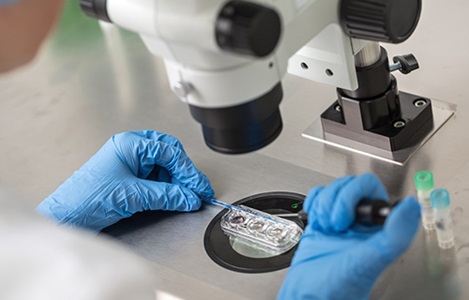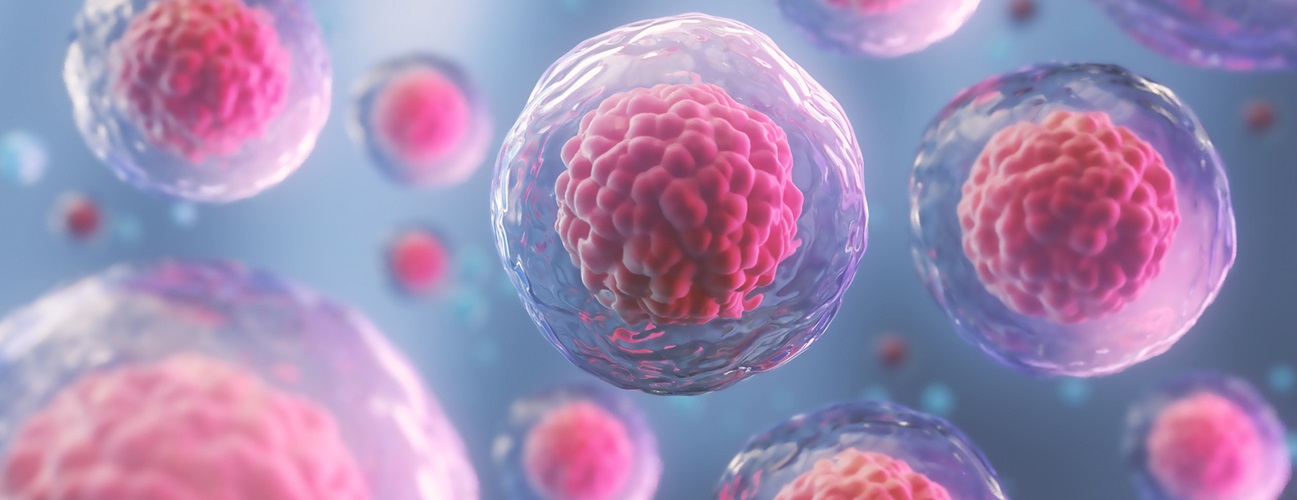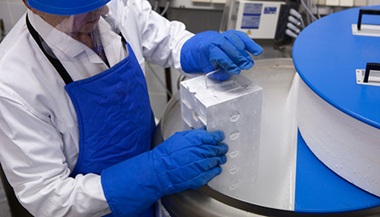Freezing Embryos
What You Need to Know
- The procedure involves removing eggs from the ovaries, fertilizing them to create embryos, letting them grow for several days and then freezing them.
- When thawed, the fertilized eggs — embryos — can be implanted either in the patient or in another person.
- Embryo transfer with thawed frozen embryos is widely used today, and pregnancy rates are similar, and sometimes even higher, than with embryos that have not been frozen.
- The first successful procedure took place in the late 1980s.
Why would I choose to have embryos frozen?
A successful in vitro fertilization (IVF) cycle can result in multiple embryos, and some people choose to freeze the extra embryos for future family building.
Patients who undergo preimplantation genetic testing (PGT) also typically freeze their embryos after they are tested as it typically takes over a week to obtain the results.
Freezing embryos is a technique that can also help preserve future fertility. Some who choose this procedure are undergoing hormone therapy, cancer treatment, gender affirmation surgery or another medical intervention that affects their fertility.
In some situations, your physician may recommend freezing your embryos to help avoid the risk of a condition called ovarian hyperstimulation syndrome, which would worsen after pregnancy. It may also be recommended to help increase the chance of pregnancy if certain hormone levels are too high during the IVF cycle.
How do I prepare for having embryos frozen?
Prior to starting a cycle to retrieve eggs to create embryos, your doctor will test your hormone levels and perform an ultrasound to ensure your ovaries are ready to begin the process. You will then take injectable medications that stimulate the ovaries to grow multiple follicles, where eggs grow and can be easily harvested from. A fertility specialist carefully follows your response to these medications.
Freezing Embryos (Embryo Cryopreservation): What Happens
When the fertility specialist determines you are ready, the doctor will harvest eggs in an outpatient procedure performed under light sedation called an egg retrieval. When you are sedated, the doctor uses ultrasound imaging to guide a hollow needle and catheter through the wall of the vagina to the ovary and collects multiple eggs, one at a time. The number of eggs collected is dependent on your response to hormone medication. The eggs can be frozen, unfertilized.
To create an embryo (a fertilized egg), an embryologist fertilizes one or more of the harvested eggs with the sperm of a partner or donor. The embryo is observed as it grows in a petri dish for five to seven days. At this stage, embryos can be sampled for genetic testing, especially if the egg or sperm donor is known to be a carrier of certain genetic conditions. The embryos are graded to determine the ones most likely to grow successfully when implanted.
At this point, the highly graded embryos can be frozen. This process, also called vitrification, replaces the water in the embryo cells with a protectant fluid, and uses flash-freezing with liquid nitrogen to prevent the formation of ice crystals that could damage the cells of the embryo.
How likely is embryo freezing to result in a pregnancy?
The chance of pregnancy from embryo transfer is largely dependent on the age of the woman when embryos are created. Procedures using eggs harvested from people age 35 or younger have the highest chances in resulting in a pregnancy. Over 95% of frozen embryos survive the thawing process.
What are the risks of freezing embryos?
Risks associated with collecting eggs from a person through an egg retrieval procedure include complications from the sedation and infection or damage to the bladder, bowel or a blood vessel from the needle and catheter. These instances are very rare. There is also a condition called ovarian hyperstimulation syndrome that can occur when the ovaries are overstimulated by the medications. It is for these reasons that patients are closely monitored during the process.
Where are frozen embryos stored?
Frozen embryos are stored and monitored at hospital facilities, usually a lab, or commercial reproductive medicine centers. They can be safely preserved for 10 years and even longer.
State-of-the-Art Assisted Reproductive Technology Laboratory at Johns Hopkins

The Johns Hopkins Fertility Center offers a full suite of fertility services in one convenient location. Our laboratories are equipped with a 24/7 monitoring system that ensures all of our frozen eggs, embryos and sperm are safely stored for best quality.
How are the embryos used to begin a pregnancy?
The process is called frozen embryo transfer, or FET. To prepare for the embryo implantation, the prospective mother may receive estrogen pills or injections to build up the lining of the uterus, and then progesterone treatment to make the uterus receptive to the embryo. Alternatively, in a “natural” FET cycle, a patient is monitored until ovulation occurs and the embryo is transferred into the uterus approximately five days after ovulation.
When the uterus is ready, the doctor inserts a catheter into the vagina, through the cervix (the opening of the uterus) and into the uterus, and carefully injects one or more thawed embryos, along with a small amount of fluid, into the uterus using a syringe. Afterward, the embryologist carefully examines the catheter under a microscope to ensure the embryo is no longer inside the device. About 10 days after the embryo transfer, a blood pregnancy test can confirm if the procedure was successful.
How much does it cost to freeze an embryo?
Freezing embryos involves costs to cover the initial hormone treatments; egg harvesting; fertility; and embryo culture, freezing, storage and implantation. Some medical insurance plans cover assisted reproduction techniques, including the procedures associated with embryo freezing.






